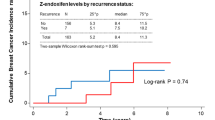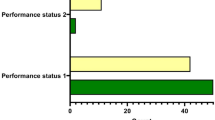Abstract
The role of pharmacogenomics and tamoxifen was investigated by analyzing several polymorphisms of cytochrome P450 and SULT1A1 gene in a nested case control study from the Italian Tamoxifen Prevention Trial. This study included 182 Caucasian subjects, 47 breast cancer (BC) cases and 135 matched controls. We used the AmpliChip CYP450 Test to screen 33 alleles of CYP2D6 and 3 of CYP2C19. One more variant for CYP2C19*17 and two single-nucleotide polymorphisms for the gene SULT1A1 were also performed. By using the AmpliChip CYP450 Test, out of 182 subjects, we identified 8 poor metabolizer (PM), 17 intermediate metabolizer (IM), 151 extensive metabolizer (EM) and 3 ultrarapid metabolizer (UM). PM women allocated to the tamoxifen arm showed a higher risk of developing BC compared to the remaining phenotypes (P=0.035). In an exploratory analysis, among 58 women with a CYP2D6*2A allele, 9 BCs were diagnosed in the placebo arm and only 1 in the tamoxifen arm (P=0.0001). CYP2C19 and SULT1A1 polymorphisms did not show any correlation with tamoxifen efficacy. Tamoxifen showed reduced efficacy in CYP2D6 PMs in the chemoprevention setting. Conversely, the CYP2D6*2A allele may be associated with increased efficacy of tamoxifen. These findings support the relevance of pharmaco-genomics in tailoring tamoxifen treatment.
This is a preview of subscription content, access via your institution
Access options
Subscribe to this journal
Receive 6 print issues and online access
$259.00 per year
only $43.17 per issue
Buy this article
- Purchase on Springer Link
- Instant access to full article PDF
Prices may be subject to local taxes which are calculated during checkout
Similar content being viewed by others
References
Fisher B, Costantino JP, Wickerham DL, Cecchini RS, Cronin WM, Robidoux A et al. Tamoxifen for the prevention of breast cancer: current status of the National Surgical Adjuvant Breast and Bowel Project P-1 study. J Natl Cancer Inst 2005; 97: 1652–1662.
Fisher B, Land S, Mamounas E, Dignam J, Fisher ER, Wolmark N . Prevention of invasive breast cancer in women with ductal carcinoma in situ: an update of the national surgical adjuvant breast and bowel project experience. Semin Oncol 2001; 28: 400–418.
Colleoni M, Gelber S, Goldhirsch A, Aebi S, Castiglione-Gertsch M, Price KN et al. Tamoxifen after adjuvant chemotherapy for premenopausal women with lymph node-positive breast cancer: International Breast Cancer Study Group Trial 13-93. J Clin Oncol 2006; 24: 1332–1341.
Fentiman IS, Fourquet A, Hortobagyi GN . Male breast cancer. Lancet 2006; 367: 595–604.
Kimura S, Umeno M, Skoda RC, Meyer UA, Gonzalez FJ . The human debrisoquine 4-hydroxylase (CYP2D) locus: sequence and identification of the polymorphic CYP2D6 gene, a related gene, and a pseudogene. Am J Hum Genet 1989; 45: 889–904.
Wilkinson GR . Drug metabolism and variability among patients in drug response. N Engl J Med 2005; 352: 2211–2221.
Sistonen J, Sajantila A, Lao O, Corander J, Barbujani G, Fuselli S . CYP2D6 worldwide genetic variation shows high frequency of altered activity variants and no continental structure. Pharmacogenet Genomics 2007; 17: 93–101.
Wedlund PJ . The CYP2C19 enzyme polymorphism. Pharmacology 2000; 61: 174–183.
Ellis KJ, Stouffer GA, McLeod HL, Lee CR . Clopidogrel pharmacogenomics and risk of inadequate platelet inhibition: US FDA recommendations. Pharmacogenomics 2009; 10: 1799–1817.
Johansson I, Lundqvist E, Bertilsson L, Dahl ML, Sjoqvist F, Ingelman-Sundberg M . Inherited amplification of an active gene in the cytochrome P450 CYP2D locus as a cause of ultrarapid metabolism of debrisoquine. Proc Natl Acad Sci USA 1993; 90: 11825–11829.
Rodriguez-Antona C, Ingelman-Sundberg M . Cytochrome P450 pharmacogenetics and cancer. Oncogene 2006; 25: 1679–1691.
Sim SC, Risinger C, Dahl ML, Aklillu E, Christensen M, Bertilsson L et al. A common novel CYP2C19 gene variant causes ultrarapid drug metabolism relevant for the drug response to proton pump inhibitors and antidepressants. Clin Pharmacol Ther 2006; 79: 103–113.
Jordan VC . Metabolites of tamoxifen in animals and man: identification, pharmacology, and significance. Breast Cancer Res Treat 1982; 2: 123–138.
Stearns V, Johnson MD, Rae JM, Morocho A, Novielli A, Bhargava P et al. Active tamoxifen metabolite plasma concentrations after coadministration of tamoxifen and the selective serotonin reuptake inhibitor paroxetine. J Natl Cancer Inst 2003; 95: 1758–1764.
Jin Y, Desta Z, Stearns V, Ward B, Ho H, Lee KH et al. CYP2D6 genotype, antidepressant use, and tamoxifen metabolism during adjuvant breast cancer treatment. J Natl Cancer Inst 2005; 97: 30–39.
Wu X, Hawse JR, Subramaniam M, Goetz MP, Ingle JN, Spelsberg TC . The tamoxifen metabolite, endoxifen, is a potent antiestrogen that targets estrogen receptor alpha for degradation in breast cancer cells. Cancer Res 2009; 69: 1722–1727.
Boocock DJ, Brown K, Gibbs AH, Sanchez E, Turteltaub KW, White IN . Identification of human CYP forms involved in the activation of tamoxifen and irreversible binding to DNA. Carcinogenesis 2002; 23: 1897–1901.
Justenhoven C, Hamann U, Pierl CB, Baisch C, Harth V, Rabstein S et al. CYP2C19*17 is associated with decreased breast cancer risk. Breast Cancer Res Treat 2009; 115: 391–396.
Schroth W, Antoniadou L, Fritz P, Schwab M, Muerdter T, Zanger UM et al. Breast cancer treatment outcome with adjuvant tamoxifen relative to patient CYP2D6 and CYP2C19 genotypes. J Clin Oncol 2007; 25: 5187–5193.
Nowell S, Sweeney C, Winters M, Stone A, Lang NP, Hutchins LF et al. Association between sulfotransferase 1A1 genotype and survival of breast cancer patients receiving tamoxifen therapy. J Natl Cancer Inst 2002; 94: 1635–1640.
Borges S, Desta Z, Li L, Skaar TC, Ward BA, Nguyen A et al. Quantitative effect of CYP2D6 genotype and inhibitors on tamoxifen metabolism: implication for optimization of breast cancer treatment. Clin Pharmacol Ther 2006; 80: 61–74.
Goetz MP, Rae JM, Suman VJ, Safgren SL, Ames MM, Visscher DW et al. Pharmacogenetics of tamoxifen biotransformation is associated with clinical outcomes of efficacy and hot flashes. J Clin Oncol 2005; 23: 9312–9318.
Goetz MP, Knox SK, Suman VJ, Rae JM, Safgren SL, Ames MM et al. The impact of cytochrome P450 2D6 metabolism in women receiving adjuvant tamoxifen. Breast Cancer Res Treat 2007; 101: 113–121.
Veronesi U, Maisonneuve P, Rotmensz N, Costa A, Sacchini V, Travaglini R et al. Italian randomized trial among women with hysterectomy: tamoxifen and hormone-dependent breast cancer in high-risk women. J Natl Cancer Inst 2003; 95: 160–165.
Bonanni B, Macis D, Maisonneuve P, Johansson H, Gucciardo G, Oliviero P et al. Polymorphism in the CYP2D6 tamoxifen-metabolizing gene influences clinical effect but not hot flashes: data from the Italian Tamoxifen Trial. J Clin Oncol 2006; 24: 3708–3709.
Veronesi U, Maisonneuve P, Costa A, Sacchini V, Maltoni C, Robertson C et al. Prevention of breast cancer with tamoxifen: preliminary findings from the Italian randomised trial among hysterectomised women. Italian Tamoxifen Prevention Study. Lancet 1998; 352: 93–97.
Veronesi U, Maisonneuve P, Rotmensz N, Bonanni B, Boyle P, Viale G et al. Tamoxifen for the prevention of breast cancer: late results of the Italian Randomized Tamoxifen Prevention Trial among women with hysterectomy. J Natl Cancer Inst 2007; 99: 727–737.
Zambon CF, Fasolo M, Basso D, D’Odorico A, Stranges A, Navaglia F et al. Clarithromycin resistance, tumor necrosis factor alpha gene polymorphism and mucosal inflammation affect H. pylori eradication success. J Gastrointest Surg 2007; 11: 1506–1514.
Gjerde J, Hauglid M, Breilid H, Lundgren S, Varhaug JE, Kisanga ER et al. Effects of CYP2D6 and SULT1A1 genotypes including SULT1A1 gene copy number on tamoxifen metabolism. Ann Oncol 2008; 19: 56–61.
Osborne CK . Tamoxifen in the treatment of breast cancer. N Engl J Med 1998; 339: 1609–1618.
Goetz M, Ames M, Gnant M, Filpits M, Jakesz R, Greil R et al. Pharmacogenetic (CYP2D6) and gene expression profiles (HOXB13/IL17BR and molecular grade index) for prediction of adjuvant endocrine therapy benefit in the ABCSG 8 trial. Paper presented at 30th Annual SABCS 10–14 December 2008; San Antonio, TX 2008. (Abstract 57).
Gaedigk A, Ryder DL, Bradford LD, Leeder JS . CYP2D6 poor metabolizer status can be ruled out by a single genotyping assay for the -1584G promoter polymorphism. Clin Chem 2003; 49: 1008–1011.
Zanger UM, Fischer J, Raimundo S, Stuven T, Evert BO, Schwab M et al. Comprehensive analysis of the genetic factors determining expression and function of hepatic CYP2D6. Pharmacogenetics 2001; 11: 573–585.
Winer EP . Optimizing endocrine therapy for breast cancer. J Clin Oncol 2005; 23: 1609–1610.
Punglia RS, Burstein HJ, Winer EP, Weeks JC . Pharmacogenomic variation of CYP2D6 and the choice of optimal adjuvant endocrine therapy for postmenopausal breast cancer: a modeling analysis. J Natl Cancer Inst 2008; 100: 642–648.
Sconce EA, Khan TI, Wynne HA, Avery P, Monkhouse L, King BP et al. The impact of CYP2C9 and VKORC1 genetic polymorphism and patient characteristics upon warfarin dose requirements: proposal for a new dosing regimen. Blood 2005; 106: 2329–2333.
Irvin WJ, Carey LA, Dees EC, Lange L, Chiu WK, Evans JP et al. Validating CYP2D6 genotype-guided tamoxifen therapy for a multiracial US population. San Antonio Breast Cancer Symposium 2009. (Abstract 410).
Decensi A, Robertson C, Viale G, Pigatto F, Johansson H, Kisanga ER et al. A randomized trial of low-dose tamoxifen on breast cancer proliferation and blood estrogenic biomarkers. J Natl Cancer Inst 2003; 95: 779–790.
Guerrieri-Gonzaga A, Robertson C, Bonanni B, Serrano D, Cazzaniga M, Mora S et al. Preliminary results on safety and activity of a randomized, double-blind, 2 × 2 trial of low-dose tamoxifen and fenretinide for breast cancer prevention in premenopausal women. J Clin Oncol 2006; 24: 129–135.
Decensi A, Robertson C, Guerrieri-Gonzaga A, Serrano D, Cazzaniga M, Mora S et al. Randomized double-blind 2 × 2 trial of low-dose tamoxifen and fenretinide for breast cancer prevention in high-risk premenopausal women. J Clin Oncol 2009; 27: 3749–3756.
Bonanni B, Serrano D, Gandini S, Guerrieri-Gonzaga A, Johansson H, Macis D et al. Randomized biomarker trial of anastrozole or low-dose tamoxifen or their combination in subjects with breast intraepithelial neoplasia. Clin Cancer Res 2009; 15: 7053–7060.
Wegman P, Elingarami S, Carstensen J, Stal O, Nordenskjold B, Wingren S . Genetic variants of CYP3A5, CYP2D6, SULT1A1, UGT2B15 and tamoxifen response in postmenopausal patients with breast cancer. Breast Cancer Res 2007; 9: R7.
Nowell SA, Ahn J, Rae JM, Scheys JO, Trovato A, Sweeney C et al. Association of genetic variation in tamoxifen-metabolizing enzymes with overall survival and recurrence of disease in breast cancer patients. Breast Cancer Res Treat 2005; 91: 249–258.
Goetz MP, Berry DA, Klein TE . Adjuvant tamoxifen treatment outcome according to cytochrome P450 2D6 (CYP2D6) phenotype in early stage breast cancer: findings from the International Tamoxifen Pharmacogenomics Consortium. San Antonio Breast Cancer Symposium 2009. (Abstract 33).
Acknowledgements
This study was supported by grants from the Italian National Research Council, the Italian Association for Cancer Research, the American-Italian Cancer Foundation, the Italian League Against Cancer and the Grieg Foundation. We gratefully acknowledge the contributions of Marcel Fontecha, Lothar Weiczorek.
Author information
Authors and Affiliations
Corresponding author
Ethics declarations
Competing interests
The authors declare no conflict of interest.
Rights and permissions
About this article
Cite this article
Serrano, D., Lazzeroni, M., Zambon, CF. et al. Efficacy of tamoxifen based on cytochrome P450 2D6, CYP2C19 and SULT1A1 genotype in the Italian Tamoxifen Prevention Trial. Pharmacogenomics J 11, 100–107 (2011). https://doi.org/10.1038/tpj.2010.17
Received:
Revised:
Accepted:
Published:
Issue Date:
DOI: https://doi.org/10.1038/tpj.2010.17
Keywords
This article is cited by
-
Genetic polymorphisms of 3′-untranslated region of SULT1A1 and their impact on tamoxifen metabolism and efficacy
Breast Cancer Research and Treatment (2018)
-
CYP2C19*2 and CYP2C19*17 variants and effect of tamoxifen on breast cancer recurrence: Analysis of the International Tamoxifen Pharmacogenomics Consortium dataset
Scientific Reports (2017)
-
A pooled analysis of CYP2D6 genotype in breast cancer prevention trials of low-dose tamoxifen
Breast Cancer Research and Treatment (2016)
-
Actionable pharmacogenetic markers for prediction and prognosis in breast cancer
EPMA Journal (2015)
-
CYP2D6 polymorphisms influence tamoxifen treatment outcomes in breast cancer patients: a meta-analysis
Cancer Chemotherapy and Pharmacology (2013)



